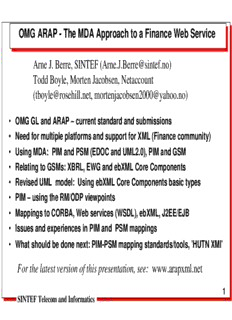
The MDA Approach to a Finance Web Service Arne J. Berre, SINTEF PDF
Preview The MDA Approach to a Finance Web Service Arne J. Berre, SINTEF
OMG ARAP - The MDA Approach to a Finance Web Service OMG ARAP - The MDA Approach to a Finance Web Service Arne J. Berre, SINTEF ([email protected]) Todd Boyle, Morten Jacobsen, Netaccount ([email protected], [email protected]) • OMG GL and ARAP – current standard and submissions • Need for multiple platforms and support for XML (Finance community) • Using MDA: PIM and PSM (EDOC and UML2.0), PIM and GSM • Relating to GSMs: XBRL, EWG and ebXML Core Components • Revised UML model: Using ebXML Core Components basic types • PIM – using the RM/ODP viewpoints • Mappings to CORBA, Web services (WSDL), ebXML, J2EE/EJB • Issues and experiences in PIM and PSM mappings • What should be done next: PIM-PSM mapping standards/tools, ’HUTN XMI’ For the latest version of this presentation, see: www.arapxml.net Arne J. Berre 1 1 SINTEF Telecom and Informatics OMG ARAP - The MDA Approach to a Finance Web Service OMG ARAP - The MDA Approach to a Finance Web Service The OMG GL (General Ledger) specification has recently been proposed extended by an ARAP (Account Receivable- Account Payable) facility. The initial submission presented in November 2001, was done in the traditional OMG style with CORBA IDL, but the revised submission is currently being done following the MDA approach through the use of modeling concepts from UML for EDOC and input from the recent UML 2.0 proposals. The presentation will report on experiences and issues in doing the platform independent model, and targeting various platforms, including CORBA, J2EE/EJB, Web services with WSDL and ebXML. Arne J. Berre 2 2 SINTEF Telecom and Informatics OMG FDTF Planned Facilities OMG FDTF Planned Facilities AR/AP Arne J. Berre Accounting Facility 3 3 SINTEF Telecom and Informatics Accounting Receivable/ Accounting Receivable/ Accounting Payable Accounting Payable The Account Receivable/Account Payable (AR/AP) Facility defines the interfaces, and their semantics, that are required to enable interoperability between AR/AP systems and general ledgers, sales and purchasing systems, and other distributed objects and applications for accounting purposes. •Extension to OMG General Ledger: •“Defines the interfaces, and their semantics, that are required to enable interoperability between General Ledger systems and accounting applications, as well as other distributed objects and applications for accounting purposes.” Arne J. Berre 4 4 SINTEF Telecom and Informatics General Ledger Interfaces Interface Purpose Primary Client(s) GLProfile Client Session Establishment All GL clients GLBookKeeping Data entry Data entry clients GLRetrieval Data extraction Reporting clients GLAccountLifecycle Account lifecycle management GL administration clients GLIntegrity Data integrity checks GL administration clients GLFacilityLifecycle GL lifecycle management GL administration clients <<Interface>> <<Interface>> <<Interface>> GLProfile GLFacilityLifecycle GLAccountLifecycle <<client>> Accounting Component <<Interface>> <<Interface>> <<Interface>> GLRetrieval GLBookKeeping GLIntegrity Arne J. Berre 5 5 SINTEF Telecom and Informatics GL Facility - Reference Architecture GL Facility GL Client (n) Book Keeping Profile (n) Retrieval GL Facility Selected Arbitrator General Ledger Interface Ledger Lifecycle Profile (n+1) Integrity Facility Lifecycle GL Client (n+1) • ... one or more GL clients makes a request for a new GL client session from the GL Facility’s Arbitrator interface. If successful, the GL Arbitrator returns a GL Profile interface which provides information about the current session, as well as making provision for controlled access to the various interfaces and operations supported by the GL Facility. Arne J. Berre 6 6 SINTEF Telecom and Informatics ARAP RFP ARAP RFP Systems which Systems which generate sales generate purchases (receivables assets) (payables liabilities) A2A integration Post Post Settlement systems (systems which mediate interparty exchanges AR/AP Ledger of value) (e.g. bank to supplier) Consolidations Reporting Systems with ARAP ledgers or General Ledgers Arne J. Berre 7 7 SINTEF Telecom and Informatics Structure – UML for EDOC Structure – UML for EDOC Chapter 1 - Response to RFP Part II - Examples & Technology Mappings Chapter 2 - EDOC Rationale & Use Chapter 6 - UML Profile for MOF Chapter 4 Patterns Chapter 3 - ECA Chapter 5 - Technology Specific Models Section 1 - ECA Rationale Section 6 - Relationships Section 1 - EJB and Java Metamodels Section 3 - Entities Section 4 - Events Section 2 - FCM Section 2 - CCA Section 5 - Processes Arne J. Berre 8 8 SINTEF Telecom and Informatics UML for EDOC and UML 2.0 - protocols UML for EDOC and UML 2.0 - protocols • Identify a “community process”, the roles and interactions • Using CCA Notation BuySell CommunityProcess Buyer Seller Buy Sell Delivery Ship Shipper Delivery Ship Arne J. Berre 9 9 SINTEF Telecom and Informatics Component structure Component structure Component structure <<Protocol>> BuySellProtocol Defines the “outside” Contract of a component <<ProtocolPort>> <<ProtocolPort>> <<ProcessComponent>> <<ProcessComponent>> <<initiates>> Buys Sells <<responds>> Buyer Seller (from Buyer) (from Seller) Seller Buyer Sell Buy Arne J. Berre 10 10 SINTEF Telecom and Informatics
Description: